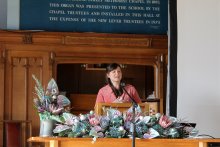
At the Platt Fisher Lecture 2025, Old Girl Dr Becky Smethurst (Class of 2008) explained how to grow a supermassive black hole.
Becky is now an award-winning astrophysicist and science communicator at the University of Oxford, specialising in how galaxies evolve together with their supermassive black holes. Her YouTube channel, Dr Becky, offers her more than 750,000 subscribers videos on weird objects in space, the history of science, and monthly recaps of space news. She also presents The Supermassive Podcast in association with the Royal Astronomical Society and regularly appears on national television and radio to explain the latest space news stories. Her latest book, ‘A Brief History of Black Holes’, has been highly praised and reached number 27 on Amazon’s worldwide book charts on its release day.
On the night, the Girls’ Division Great Hall was filled with current and former pupils and their families, members of staff and those from the local community with an interest in space and astrophysics. Among the audience was Dr Sheila Fisher, the namesake of the Platt Fisher Lecture.
Following a brief welcome from Mrs Lynne Kyne, the Head of Girls’ Division, Head Girl Nia Pomian introduced Dr Becky with a brief recap of her career so far: after leaving Bolton School, she went on to earn a first class degree in Physics and Astronomy from Durham University, followed by a doctorate in Philosophy at Oxford University, where she is currently a Junior Research Fellow. In 2022, she was awarded the Royal Astronomical Society's Winton Award for Research and was applauded for having a career that showed the most promising development.
Becky herself then took to the stage to talk about her ‘favourite subject’: black holes. She challenged and dispelled some of the most common misconceptions about black holes, explaining that they are not technically holes or black, and that they don’t actually suck things up like hoovers! She spoke about how and why black holes form, and why it is very difficult to grow supermassive black holes such as the ones at the centre of galaxies.
She went on to talk about the future of the Milky Way and Andromeda Galaxies, which in several billion years will merge to form a spheroid galaxy: in doing so, the black holes at the centre will grow due to the disruption to the stars’ orbits, and eventually merge and double in side. Becky explained that galaxies merging was the accepted theory on how supermassive black holes grow, but that there is a problem with this idea: not all galaxies have merged, but they still have a supermassive black hole. She then talked about her current research topic, which involves measuring the masses of growing supermassive black holes in galaxies that have never had mergers. Becky explained how she does this, which involves using the Hubble Space Telescope, travelling around the world to use ground telescopes such as the Isaac Newton Telescope in the Canary Islands, and working through the night to get the images she needs. In addition, she talked about the science behind the calculations required to measure a black hole’s mass and said:
‘That blows my mind, not only that this is my job but the fact that humans have figured out how to do that. Think about how many advancements that had to be in chemistry and engineering of telescopes and physics, every single little bit of knowledge all piling on top of each other like a big house of cards until eventually we figured out as humans how to do that. I get goosebumps just thinking about it! I think it's absolutely incredible.’
In the Q and A session after her talk, Becky was asked whether she would ever visit space, which telescope in the world was the most interesting to visit, and even who is the coolest scientist! She also answered questions about what piqued her interest in black holes, dark matter, and why we should invest in research into black holes.
Re-watch the Platt Fisher Lecture 2025:
Photos from the Platt Fisher Lecture 2025:
























